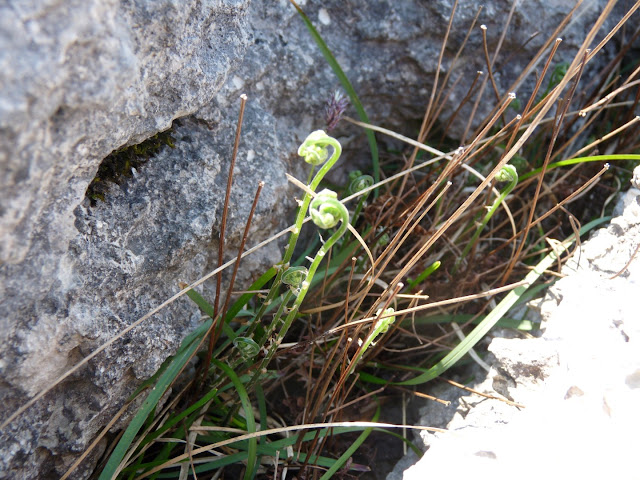18th April 2020
Today I was able to find lots of early developing Gymnocarpium robertianum (Limestone Fern)
Gymnocarpium robertianum (Limestone Fern or Limestone Polypody)
This photo shows early stages of development
shows it with early opening of the croziers and taking on its true lime green colours.
Photo: Burton Fell 18th April 2020
Gymnocarpium robertianum (Limestone Fern or Limestone Polypody)
This photo shows the fern in its early secondary stages with the croziers now fully open,
yet awaiting straightening of frond. This looks well growing vertical from a open gryke
Photo: Burton Fell, Hutton Roof Crags (CWT) 18th Apr 2020
Gymnocarpium robertianum (Limestone Fern or Limestone Polypody)
This photo shows the early tight croziers of the fern before opening
you may note it is a very much darker green
Photo: Burton Fell, Hutton Roof Crags (CWT) 18th Apr 2020
Emergence photos (12th April 2019)
Gymnocarpium robertianum (Limestone Fern or Limestone Polypody)
Photo: Holme Stinted Pastures (Hutton Roof) on 12th April 2019
Showing croziers at onset
Gymnocarpium robertianum (Limestone Fern or Limestone Polypody)
Photo: Holme Stinted Pastures (Hutton Roof) on 12th April 2019
Showing croziers at onset
Gymnocarpium robertianum (Limestone Fern) Click over to enlarge
Photo: 29th April 2019 - Holme Stinted Pastures in the shadow of Hutton Roof
Fresh fronds within the shallow gryke
Gymnocarpium robertianum (Limestone Fern) Click over to enlarge
Photo: 29th April 2019 - Holme Stinted Pastures in the shadow of Hutton Roof
Close up of individual frond
Gymnocarpium robertianum (Limestone fern or Limestone polypody)
Showing at about 3-4 weeks after emergence on 9th May 2018
Gymnocarpium robertianum (Limestone Fern or Limestone Polypody) Click over to enlarge
Photo taken on Dalton Crags on 1st June 2017
Gymnocarpium robertianum (Limestone Fern or Limestone Polypody) Click over to enlarge
Photo: taken on 1st June 2017
Gymnocarpium robertianum (Limestone Fern or Limestone Polypody)
Photo: taken 1st June 2017
Gymnocarpium robertianum (Limestone Fern or Limestone Polypody) Click over to enlarge
Photo taken on Dalton Crags on 9th June 2016
Gymnocarpium robertianum (Limestone Fern or Limestone Polypody) Click over to enlarge
Photo taken on Dalton Crags on 12th June 2013
Gymnocarpium robertianum (Limestone Fern or Limestone Polypody)
Click over to enlarge
Photo taken on 12th June 2013
"A wet version"
Gymnocarpium robertianum (Limestone Fern or Limestone Polypody)
Click over to enlarge
Photo: 23rd June 2015 - Lancelot Clark Storth (CWT)
Gymnocarpium robertianum (Limestone Fern or Limestone Polypody)
Click over to enlarge
Photo: 23rd July 2015
Gymnocarpium robertianum (Limestone Fern or Limestone Polypody)
Click over to enlarge
This shows old fronds and how they go discoloured with ageing.
Photo: taken on Burton Fell on 14th August 2014
Gymnocarpium robertianum (Limestone Fern)
Dalton Crags on Wed 13th May 2020
Gymnocarpium robertianum (Limestone Fern)
Dalton Crags on Wed 13th May 2020
Gymnocarpium robertianum (Limestone Fern)
Dalton Crags on Wed 13th May 2020
Gymnocarpium robertianum (Limestone Fern)
Dalton Crags on Wed 13th May 2020
Gymnocarpium robertianum (Limestone Fern)
Dalton Crags on Wed 13th May 2020
Gymnocarpium robertianum (Limestone Fern)
Dalton Crags on Wed 13th May 2020
Gymnocarpium robertianum (Limestone Fern)
Dalton Crags on Wed 13th May 2020
Gymnocarpium robertianum (Limestone Fern)
Dalton Crags on Wed 13th May 2020
Gymnocarpium robertianum (Limestone Fern)
Dalton Crags on Wed 13th May 2020

Gymnocarpium robertianum (Limestone Fern)
Dalton Crags on Wed 13th May 2020
.JPG)

















































